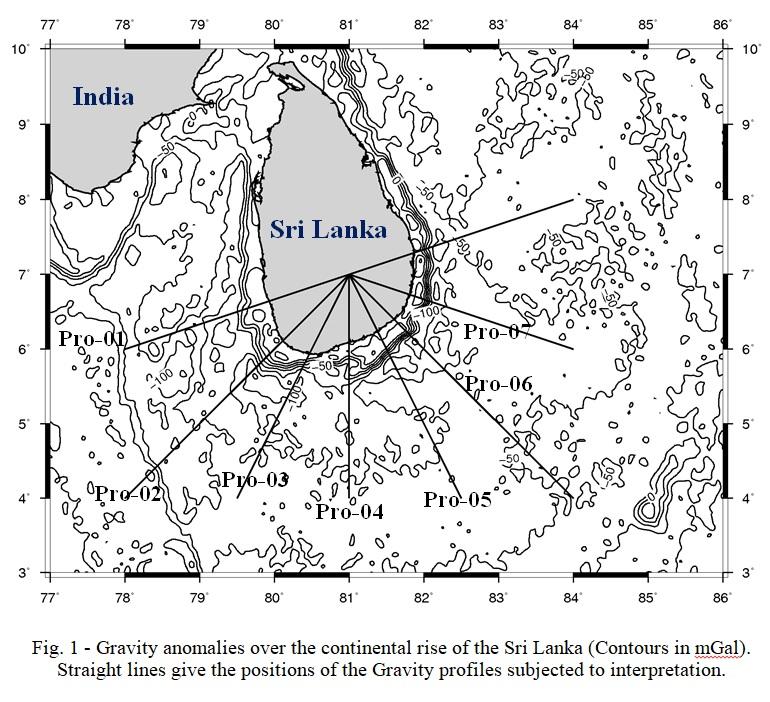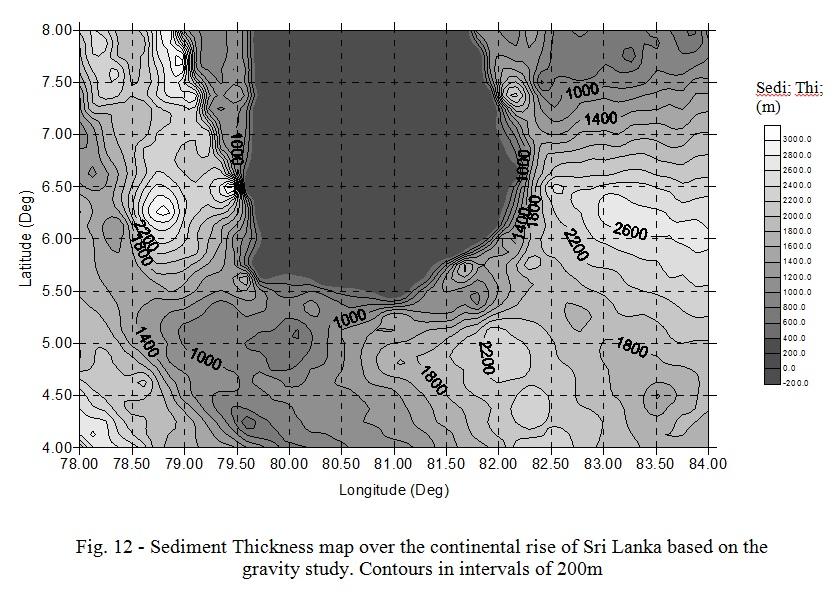Interpretation of Gravity Anomalies over the continental rise of Sri Lanka (2017)
Dr. M. M. P. M. Fernando and Prof. D. A. Tantrigoda
Abstract
Seven Profiles of intense negative gravity anomaly over the South Western, Southern and South Eastern parts of the continental rise of Sri Lanka have been interpreted two dimensionally. Results of the interpretation of profiles were interpolated and a map of sediment thickness has been compiled. As revealed by the interpretation and the map compiled there are three noticeable sediment distributions with thickness varying from approximately 2.5 km to 3.5 km. Sediment thickness map in this study closely agree with that compiled using seismic studies by previous workers.
Furthermore, results of this study may have applications in the oil and gas exploration activities over the region.
Introduction
One of the most prominent features of the satellite gravity anomaly map of the Indian Ocean around Sri Lanka is the intense negative anomaly situated approximately over the continental rise of Sri Lanka (Fig. 1). This anomaly, which takes the shape of a crescent, goes down to a minimum value of –70 mGal. Approximate total extent of the anomaly is 2 x 105 km2. It is suspected that this anomaly is caused due to the sediments accumulated beyond the foot of the continental slope of Sri Lanka (Tantrigoda, 2004). Gravity anomalies have been interpreted to estimate thickness of sediment distribution and a map of sediment thickness has been compiled.
Discussion
An isopach map over the continental rise of Sri Lanka has been compiled using results of two-dimensional interpretation of seven profiles of satellite gravity anomalies. This map closely agrees with the isopach map compiled by Levchenko et al. (1993) based on seismic studies carried out along several lines and interpolating results.
As can be seen in Fig. 10, there is an intense negative anomaly adjacent to the positive anomaly over the continent. Positive anomaly over the continent is mainly due to the density contrast between seawater and continental crust of the continental shelf. Negative anomaly is due to the oceanic crust to continental crust transition and also due to replacement of upper mantle material by continental crust. Therefore, negative anomaly observed over the foot of continental slope cannot be explained as a result of sediment accumulation alone. Gravity variation due to change of rock type over the above mentioned boundaries has also needed to be considered.
In case of Profiles P2 and P3 intense negative anomaly discussed above is situated almost over the transition boundary. Therefore, the negative anomaly is mainly due to the density variation over the boundary. In case of profiles P1, P4, P5, P6 and P7 negative anomaly is situated reasonably away from the transition boundary towards the continent. Therefore, both sediment accumulation and density variation over the boundary may have contributed towards it. This explains why sediment thickness is low over the profile P2 and P3 even though gravity anomalies are more negative. Crescent shaped sediment accumulation suggests that the sediments coming down from the Bay of Bengal may have been trapped around the continental rise of Sri Lanka due to 85oEast Ridge, which curves towards west around 4oS


